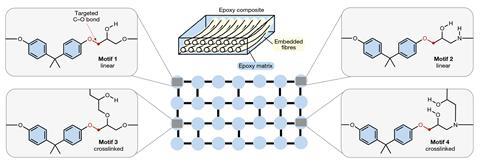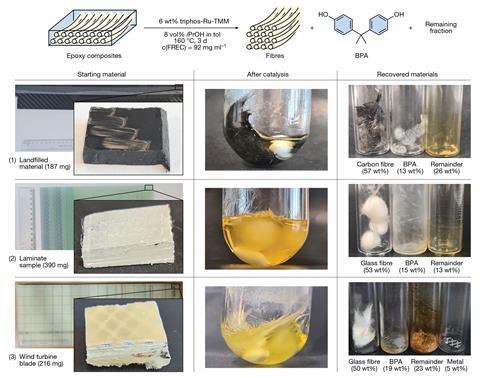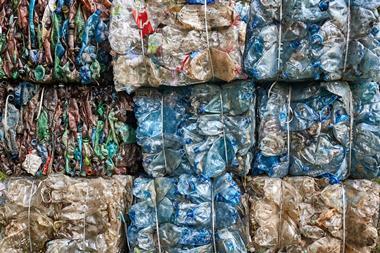Epoxy resins used to produce wind turbine blades have been recycled using a method that can selectively break certain bonds, making the building blocks of these materials available to reuse again and again.1 ‘This was considered too challenging until now, due to the chemical inertness of epoxy polymers,’ says Alexander Ahrens from the Interdisciplinary Nanoscience Center at Aarhus University, Denmark. ‘Using a ruthenium-based catalyst, our method targets a specific C–O bond formed during the production of the resins.’ Epoxy composites are very robust, so they’re commonly found in a range of products like plane wings, cars and also wind turbine blades, but recycling isn’t easy, so these parts usually end up in landfills eventually.
‘That’s very undesirable due to the massive size of the structures and the loss of value,’ says Ahrens. Because of this and for environmental reasons, landfilling of wind turbine blades has already been banned by several European countries. ‘It’s also important to note that none of the large commercial wind farms have been decommissioned yet, so most deactivated blades aren’t there yet but coming soon,’ adds Ahrens.
Epoxy composites are made by gluing glass or carbon fibre meshes together with a crosslinked epoxy polymer. ‘This crosslinking makes the materials extremely strong, but it also means that they can’t be melted or dissolved. Therefore, thermosets can’t be mechanically recycled,’ explains Ahrens. With the team’s approach, the polymers can now be completely solubilised to recover high-quality fibres that can be reused to make new materials. The method also recovers bisphenol A (BPA) from the resins. ‘The recovered BPA is of high quality too and could be reintroduced into existing production chains,’ notes Ahrens.
To recycle the composites, the researchers added pieces of the material into a mixture of toluene and isopropanol, added a ruthenium catalyst and heated the reaction mixture to 160°C. ‘It’s a slow process, so it takes around three days, but in this time the polymer is completely disassembled,’ says Ahrens.

‘I’m excited to see that the chemistry community is starting to look more seriously at the problem of thermoset recycling, especially as the retirement of the first generation of carbon fibre epoxy composite aircraft is approaching,’ comments Travis Williams at the University of Southern California, US, who wasn’t involved in the study. ‘It’s also very nice that this method tolerates glass fibres, which don’t behave well with reduced pH digestion conditions.’
Carlos Navarro, who works with Williams on chemical methods for recycling fibre-reinforced polymers, adds that this is an important step towards improving the circularity and sustainability of useful composite materials. ‘The researchers saw the recycling barrier of these composites as chemical, because of the strong epoxy resins, and tailored their recycling chemistry to target the epoxy’s vulnerabilities,’ he says.

The team used the new approach to recycle a piece of carbon-fibre-based composite, a commercial fiberglass sample and a decommissioned wind turbine blade. ‘The method works on commercial materials that are being used right now,’ says Ahrens. But he adds that large amounts of catalyst are required. ‘This is problematic as it’s an expensive and rare transition metal. We do hope that through catalyst design and optimisation, it might be possible to reduce the amount of catalyst drastically. Only if that is possible, would upscaling be viable.’
References
A Ahrens et al, Nature, 2023, DOI: 10.1038/s41586-023-05944-6















No comments yet